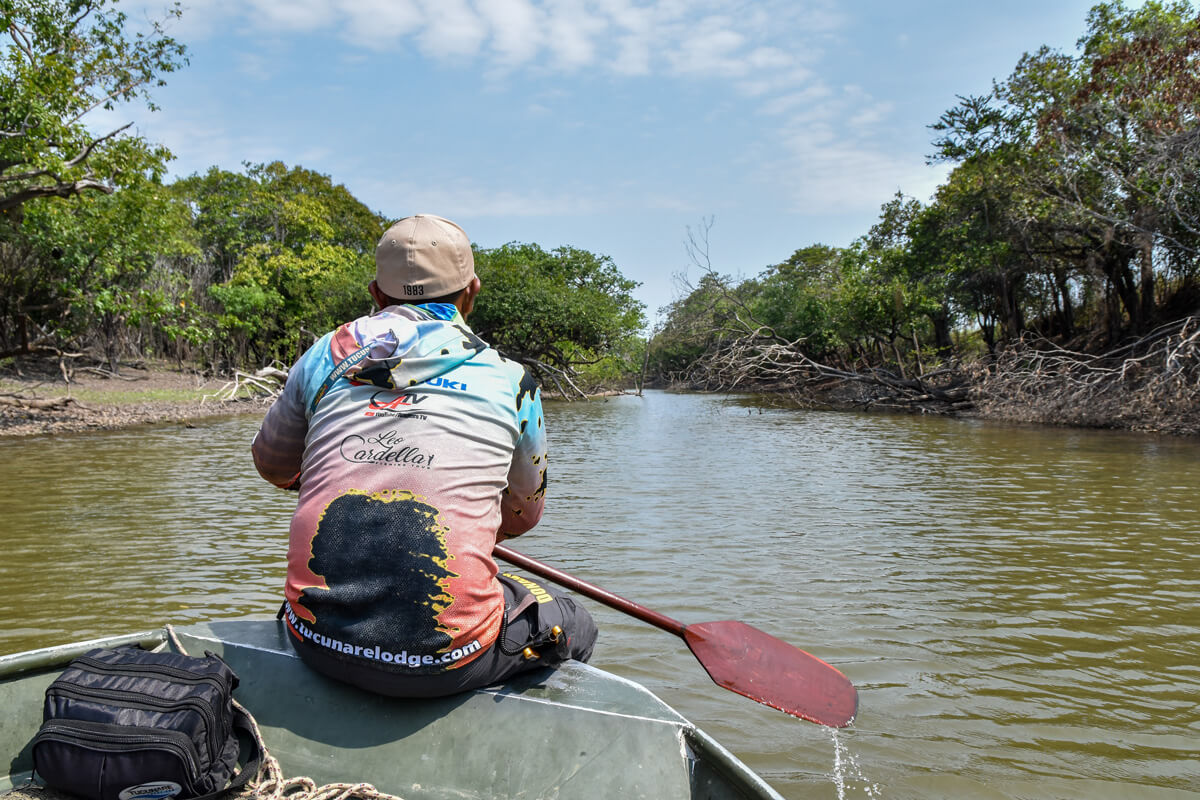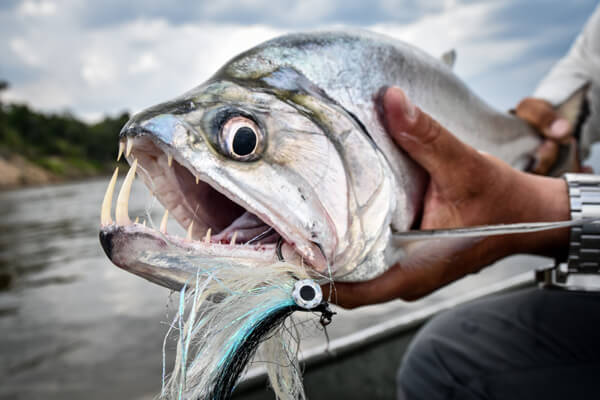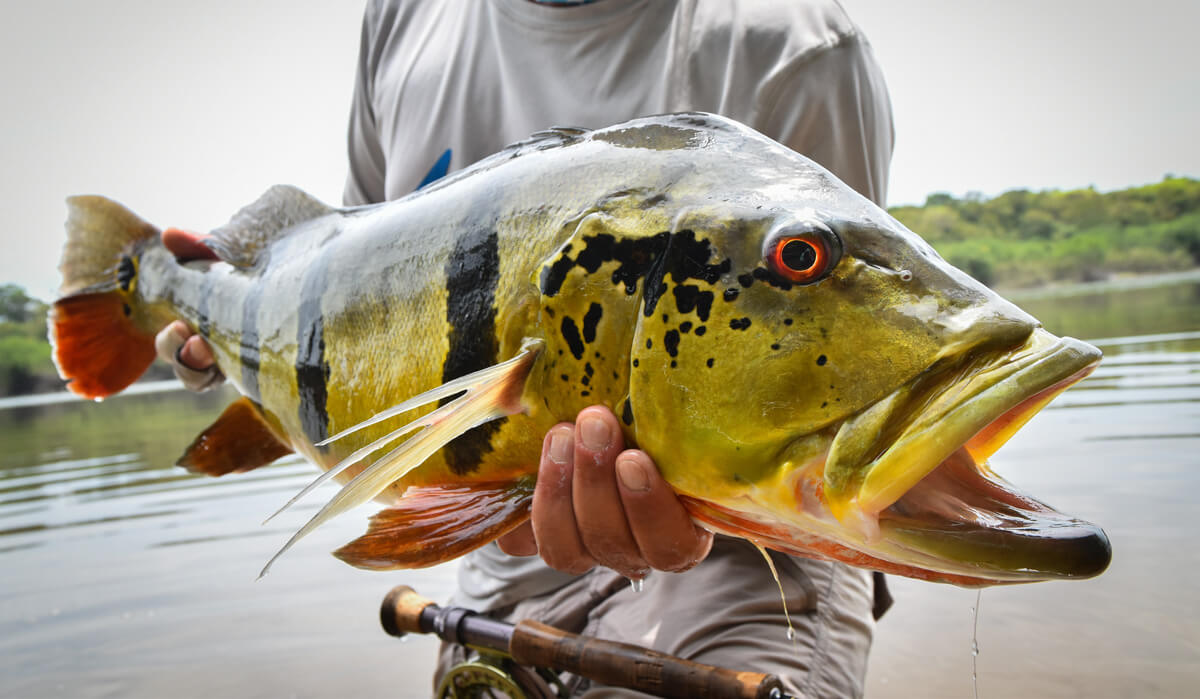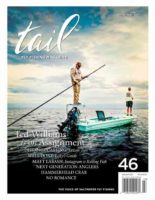Places with spectacular fishing usually exist for one of two reasons; either they’re shielded by sheer remoteness (think Alaska or Mongolia) or they’re made inaccessible by civil unrest and political instability (e.g., Kamchatka and Cuba). Colombia, with its long history of violence and vast, impenetrable jungles, is both.
Paradise Rediscovered:
Fly Fishing for Payara and Peacock Bass in the Colombian Jungle
Ryan Sparks
Just the word Colombia conjures up images of gun-wielding narcos, exploding passenger jets, and square white bundles of tightly wrapped cocaine—a lawless nation barely keeping a lid on rising anarchy. Despite years of relative peace, Colombia still holds a reputation as a place where kidnappings, extortion, and killings are a part of daily life. Fly fishing is not something that immediately jumps to mind.
Until recently, news coming out of Colombia wasn’t good. The FARC, a hostile Marxist guerilla group working hand in glove with drug cartels, terrorized the country with kidnappings and assassinations for decades. For nearly 40 years, clashes between the FARC and the Colombian military made international headlines as the country careened into chaos. These skirmishes often occurred on jungle rivers where massive peacock bass and brutish payara swam below, protected by the firestorm overhead. That is, until recently.
In 2012, strengthening government forces drove the FARC from Colombia to neighboring Venezuela, where around 1,000 FARC dissidents remain today. This purge, along with recent peace agreements, has brought stability to the once-volatile nation, opening regions and rivers that have seen more firearms than fly rods. In 2013, Tucunare Lodge, a partnership between the indigenous Sikuani people of the Vichada River and lodge operator Alejandro Diaz, along with assistance from the Travel and Tourism Board of Colombia, began operating with the intent of showcasing the incredible peacock bass and payara fishing in the region. When my friend (and partner in the lodge) Javier Guevara invited me to see it for myself, I couldn’t say no.
Orinoco Flow
After a brief layover in Florida, I landed in Bogota, Colombia’s capital and largest city. Bogota sits 2 miles above sea level, framed by lush green mountains to the east. In the 1990s, Bogota was a dangerous place to be, but now it’s a lively metropolis and the economic heart of the country. As my taxi driver wove through Bogota’s vibrant neighborhoods, the city hummed with energy. This wasn’t the Colombia I had seen in movies and television dramas—just regular people going about their daily lives.
Guevara welcomed me when I arrived. He has been exploring the jungles of Colombia since 2016 and specializes in taking people to uncharted fisheries all over the world through his companies Ecuador Fly Fishing Tours and In the Loop Outfitters. Guevara and I sat outside watching the life of the city streets, drinking beer, and talking about the days to come.
The next morning, we flew to Inírida, in the eastern Guainía region of the Orinoco basin. When we landed, there were around 100 soldiers packed into the tiny airport. The heavy military presence is the result of Iníridas strategic location and troubled history as a region of cocaine production. Guainía translates to “land of many waters” and Inírida, appropriately situated at the confluence of the Guaviare, Atabapo, Inírida, and Orinoco Rivers, is the sleepy gateway to more remote parts of the country. There are no roads or airstrips connecting the indigenous villages within the interior. Cut off from the rest of the country, the only way in is by boat.
From the airstrip we made our way to the river, picking up supplies along the way: several bags of potatoes, ten dozen eggs, purified water, some Colombian lager, and a few bottles of a local anise-flavored hooch called aguardiente, which roughly translates to “fire water.” Cumbia, a distinctly Colombian music, blared from the bar across the street, where locals drank and watched us haul our gear to the covered longboat waiting to take us over 100 miles upriver. Once we had made the proper arrangements with local military officials and the boat was loaded, we motored upriver toward the Orinoco.
As we continued, small villages and riverside homes became less frequent until the bank was dominated by thick jungle. The Orinoco serves as the natural border dividing Colombia and Venezuela. Depending on the river channel, sometimes we were in Colombia and other times we swerved into Venezuela. It was normally a fluid border, but recent conflicts involving Venezuelans fleeing the human rights and humanitarian crisis in their home country and an unreceptive Colombian government had increased tension in the area. Violent confrontations involving civilians, armed groups, the Venezuelan army, and Colombian immigration authorities had recently dominated the news, although we saw no sign of this unrest.
Through pockets of rain forest, we twisted against the current, stopping once to haggle over fuel. With only a rudimentary understanding of Spanish, I couldn’t make out exactly what they discussed, but it seemed both the price of fuel and how watered-down it was were topics of conversation. When we finally came to an agreement, we siphoned gasoline out of a plastic drum and continued upriver. When we met the confluence with the Vichada, the muddy water turned to a dark tannic stain.
Tucu Grande
When we arrived at the village, the entire community was waiting to greet us. Children waved from the bank, older men and women stood watching from a bluff high above the river, and dogs barked and paced anxiously along the shore. Tucunare Lodge exists because of a unique partnership with the Sikuani people. In fact, the lodge could be viewed as an extension of the village. It employs nearly every one of the 35 adults who live there as cooks, guides, handymen, and housekeepers. Besides employing the village, a portion of the lodge’s profits go to support the community. Several years ago, Tucunare Lodge helped build a school and employ a teacher. Since the school’s construction, the village has sent several of its youth to universities in Bogota.
As the boat slid onto shore, several men helped us lug our gear up the 50-foot bank. The steep banks that line the river result from changing water levels. In part, it’s these drastic fluctuations that make the fishing here so good. During the rainy season, water can rise up to 50 feet, flooding vast swaths of jungle and making it possible for peacock bass to push into normally inaccessible lagoons. When the water recedes, predatory species are left with a captive population of baitfish and grow to enormous sizes. Furthering this growth, members of the community have realized that peacock bass and payara are more valuable for sport than food, and they’ve stopped netting the lagoons, increasing both the size and number of fish.
The next morning, we loaded our rods and gear into 15-foot aluminum boats outfitted with 40-horsepower engines. I fished with Leo Cardella, a partner in Tucunare Lodge. After a brief discussion with our guide, we sped downriver, stopping at a point where a trickle of water poured from the jungle. Approaching the source, a narrow opening appeared. Cardella moved to the bow of the boat, paddling at times and getting out to pull the boat through the shallows at others. At one point, we used a machete to cut away a tangle of vines that blocked our passage. Later, we had to lay prone in the boat to squeeze under a fallen tree. Cardella made a note to bring a chainsaw the next time he returned.

After a half hour of bushwhacking up the narrow rivulet, it opened into a long, slender lagoon. Everywhere the splashy rises of baitfish dimpled the water, and in the distance the sound of howler monkeys resembled wind careening through a tunnel. We slowly worked our way down the shoreline, making long casts that put our flies as close to the bank as possible. After 30 minutes with no results, I changed to a floating line and an 8-inch articulated popper.
Within a few casts, a large peacock exploded on the fly. The take sounded like someone dropped a bowling ball into the water off a ladder. The fish made several powerful runs that left my hands striped with line burns. I thought I was gaining line when the fish turned and bolted into open water. I heard a loud clunk as the spool separated from my reel and clattered to the bottom of the boat. I somehow hand lined the fish to the boat, but when we got the BogaGrip around its lower jaw, it surged and took off on another run, grip in tow. After another five minutes of coaxing the fish back to the boat, the guide grabbed the Boga and hoisted the fish into the boat. We were rolling with laughter at this comedy of errors when he handed me the fish. The scale on the Boga measured an even 19 pounds—one hell of a peacock bass.
That fish happened to be the variety of peacock bass from which the lodge takes its name. Cichla temensis, commonly called tucunare, is the largest variety of four recognized species of peacock bass. Peacocks aren’t related to the largemouth or smallmouth bass of North America but comprise a genus within the Family Cichlidae. Cichlids are an ancient line of fish established nearly 60 million years ago when South America, Africa, Australia, and southern Asia were a single continent. Upon the continents’ separation, these mutual ancestors evolved independently, forming the fish we know today.
The next few days continued along the same lines. Each day we explored a new lagoon, catching many nice fish in the process. We fished until the overhead sun became too much to handle, and then retreated to the shade for lunch and a short hammock siesta. Back in the boat, we fished until sunset, returning to the lodge for dinner, a shower, and to share the day’s stories.
Muscle and Teeth
 To keep fishing pressure low, Tucunare Lodge accepts only eight anglers at a time. Week-long trips are divided into five days of peacock bass fishing in the system of lagoons and bays off the Vichada River. Anglers rotate, making longer runs up the Orinoco in search of payara the additional two days. Sometimes called vampire fish, payara are as aggressive as peacock bass, but they differ greatly in their fondness for current. Where peacocks prefer to loaf and hunt in still water, payara are drawn to current for the conveyor belt of food it provides. Spending much of their time in strong-flowing water, they are streamlined, brutish fighters.
To keep fishing pressure low, Tucunare Lodge accepts only eight anglers at a time. Week-long trips are divided into five days of peacock bass fishing in the system of lagoons and bays off the Vichada River. Anglers rotate, making longer runs up the Orinoco in search of payara the additional two days. Sometimes called vampire fish, payara are as aggressive as peacock bass, but they differ greatly in their fondness for current. Where peacocks prefer to loaf and hunt in still water, payara are drawn to current for the conveyor belt of food it provides. Spending much of their time in strong-flowing water, they are streamlined, brutish fighters.
We started our payara fishing by targeting side channels with swift current off the main river. This style of fishing resembled drift boat streamer fishing for trout. We floated with the current, making repeated casts into eddies, behind boulders, and around logjams. Once we had floated past a productive stretch of water, we would motor upstream and start again. Fishing this way, we caught several small- to medium-size payara, often pulling fish from the same eddy on multiple passes.
Payara require repetitive casting. You’ll often work the same water over and over until you present the fly just right. In such fast current, even weighted flies and sinking lines have trouble getting down before the fly begins to swing. The demands of casting result in aching elbows, wrists, and shoulders. It can also be mentally challenging, especially in the heat of the day when you’ve been casting nonstop since daybreak. Making things more challenging, payara have a mouth of teeth and bone, with not much else to hold onto. When hooked, they fight as hard as chinook salmon fresh from the salt. With the combination of their bony mouths, scrappy disposition, and the strong current where they live, we lost at least half of the fish we hooked.
After lunch we decided to focus on deeper holes and chutes where Cardella and the guide had found big payara in the past. In these places, we attached the boat to gigantic slabs of volcanic rock and hopped out to fish on foot. From time to time we would see large boils in the white water, occasionally catching a glimpse of a silver flank as baitfish exploded from the water. Our efforts proved to be in vain, though, and after two hours of working the same water again and again we had nothing to show for our efforts.
There are certain fish that stand as signposts for those who measure their life in fish. Some of them come after months of planning and hard work, but most come when you least expect it. This one was no different. On a cast indistinguishable from the previous hundred I had made, I sensed that distinct nothingness at the end of my line that comes the instant before you feel the weight of a fish, that brief moment when the fly is in a fish’s mouth and neither of you knows the other is there yet. I strip-set hard and an enormous payara simultaneously tugged in the other direction, pulling the line from my hand, and jumping as it tore downriver. When I saw backing, I tightened the drag and the fish slowed, seeming to calculate its next move. For ten minutes it was a stalemate: I would gain a small amount of line only to have the fish pull it back off the reel moments later. I fully expected the hook to come loose at any moment. When the payara was 15 feet away, it hurdled out of the water and made us fully aware of its size. The guide said something in his native language that I couldn’t directly translate, but I understood it to mean something like, “Holy shit!”
Pulling the fish to the bank, I grabbed its tail and held tight as it made its last sullen headshakes. That moment will forever be seared in my memory. Later, when our guide recounted the story back at the lodge, Diaz told me he thought it was the largest payara they had caught that year. Remembering my peacock from earlier in the week, I reflected that most anglers are lucky to find one fish of that caliber in a decade, let alone two in a single week. Either by fate or by luck I had managed to connect with two extraordinary fish in the jungles of Colombia.
A World Divided
Being in such a remote location, 115 river miles from the nearest town, it’s easy to romanticize life in the Colombian jungle. The Sikuani seem to live in another world, not one any better or worse than our own, but still a world apart. Albeit, their world grows more connected with the outside every day.
Women washed clothes in the river, beating them against a plank with a wooden club while their husbands simultaneously carried 50-horsepower outboards down to the water on their shoulders. We encountered people from neighboring villages navigating the river in dugout canoes as frequently as we saw military patrols zoom by with 30-caliber machine guns mounted to the bow.
Despite how it feels, this place isn’t frozen in history. Colombia’s legacy of violence has left vast swaths of the country unknown, even to its own citizens. The first few days of the trip I was frustrated that I couldn’t keep the guides’ names straight. Just when I was certain I knew a name, I would hear them addressed by a different name. Later I learned most of the men have three names: their indigenous name, their Spanish name, and the remnant nicknames pressed upon them by members of the drug cartel when they operated in the area.
Despite all this, Colombia has changed immensely over the past ten years and is still changing for the better. Despite its reputation, there was never a single moment when I felt in danger. This isn’t Miami Vice. The people of Colombia, from the indigenous people to cab drivers, waitresses, and even people I passed on the street, are one of the friendliest and welcoming communities I have ever met. They are striving to show the richness of their culture and the beauty of their country.
The locals navigate between these two worlds, and such a juxtaposition makes you realize how complex and intertwined the world has become. It would have been worth the trip just to experience their way of life. Throw in peacock bass and payara in an incredibly beautiful setting and you have a truly unique experience. Every night I stood atop a high bank overlooking the verdant jungle skyline. I could feel the energy of the place and looked up at a moon I could seemingly reach out and touch, and at the stars that remained constants across civilizations, colonization, war, and violence, which hang still in an eternal sky.



